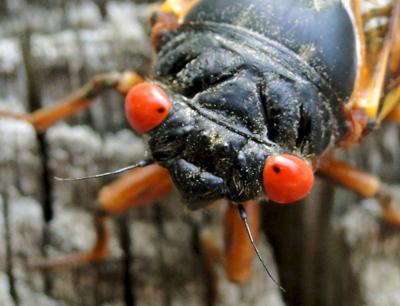The cicadas are coming!
A brief overview of Brood X (aka, the 17-year cicadas)

Here’s looking at you!
April 7, 2021
If there’s ever been a time to overcome your entomophobia, this summer is most certainly it.
This summer of 2021, the 17 year cicadas will be emerging from the ground in our New Jersey area, as well as in the majority of the Northeast of the United States. As many as 1.5 million per acre may emerge – expect trillions across the board. Though they are harmless to humans, they are very incredibly loud, especially in such large numbers, and most definitely not a pleasant sight.
The scientific name for these periodical cicadas is Magicicada – quite literally, magic cicada. The reason for their periodic appearances is unknown, but is speculated to be for avoiding other predator cycles. This factor in their life cycle awards them the title of longest-living insect known to man. Unlike the annual cicadas we are used to, which are green in color, periodical cicadas have black bodies and red eyes, and are about the size of your thumb.
“Cicada” has become interchangeable with “locust,” because when periodical cicadas were first encountered in colonist times, they reminded settlers of the biblical plagues of locusts. Though locusts are actually a type of grasshopper, the two words have become synonymous.
There are two types of periodical cicadas. The 17 year kind are located in the eastern, upper midwestern, and Great Plains states of the US. The 13 year kind are located in the southern and Mississippi valley states. The last times either of these cicadas emerged were 2004 and 2015 respectively.
The term brood refers to the periodical cicadas that exist on the same life cycle and emerge in a given year. This year’s brood is known as brood X, or the Great Eastern Brood. You can take a look on Where will 17 & 13 Year Periodical Cicada Broods emerge next? – Cicada Mania to see for yourself what states it will be affecting.
It is one of the largest broods in existence, and will begin to emerge in April and May. Wooded, suburban areas will be filled with the whistling of cicada calls for about four weeks as they look for mates and eventually lay eggs on tree branches. When the adult cicadas die, cicada nymphs will hatch from the eggs, fall to the ground, and burrow underneath to emerge in another 17 years after slowly maturing.
When the weather is especially warm and sunny, the cicadas will be the most active and therefore, the most boisterous. Some entomologists predict that the noise will reach levels up to 80 to 100 decibels – comparable to that of a lawnmower or a jet aircraft passing by overhead.
That being said, prepare yourself now. Unfortunately, the best you can do is a pair of ear plugs and some patience. If you can manage the creepy eyes and endless noise, you may also be able to see beyond the disturbance for a rare event you won’t see again until 2038.


Ana Generelli • Jun 8, 2021 at 3:23 pm
woaa, I didn’t know most of this stuff! Great article!